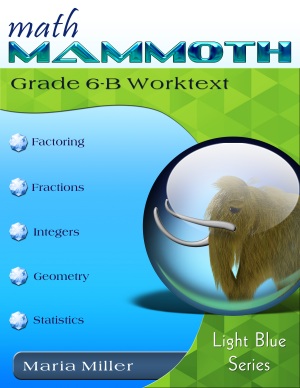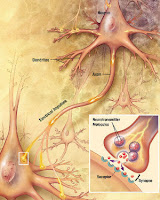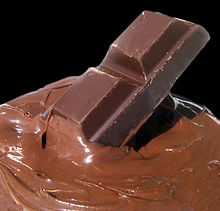
Maria's Math News, Vol. 75, September 2013
I love teaching, and I love math. This newsletter is my way of reaching out and helping you to teach it, too.
Trouble viewing this email? Click here
Make sure I reach your inbox! Add maria_miller@mathmammoth.com to your address book. Learn how.
Make sure I reach your inbox! Add maria_miller@mathmammoth.com to your address book. Learn how.
Hello again!
In this newsletter, we will have some chocolate math along with learning about PRAISING our students. Then there's a special song, What About the Kids. Please note also that later this month, I will be sending out information about two different giveaways, just for my subscribers!
~Maria
 |
On-line, self-paced, multimedia math lessons that are reasonably priced. Pre-algebra, Algebra, and Geometry lessons that Go to www.teacher4-u.com/HomeSchool.html to get the "Home School Math" special: view 10 lessons for the low price of only $5. That's up to a $20 savings! |
|---|
1. Math Mammoth news
2. What kind of PRAISE should we give to our children & students? (grades PreK-12)
3. What About the Kids? (all ages)
4. Free worksheets: ratio word problems, GCF, LCM (grades 5-8)
5. Find your age using chocolate math 2013 (grades 3-12)
1. Math Mammoth news

- Math Mammoth Grade 6-A, revised version is now available. I am releasing it ahead of schedule (while 6-B is being under construction) for those people's sakes who want to use it for this school year.
Download a sample file (PDF) here.
You can read about the changes between the old and the new versions here.
Order it at Kagi store here -- you will need to scroll far down. -
Now available for downloading - catalogs for Math Mammoth products. Choose from the list below. All are PDF files.
Light Blue Series Catalog (PDF download, 6.8 MB)
Blue Series Catalog (PDF download, 14.4 MB)
Golden and Green Series Catalog (PDF download, 4.8 MB)
2. What kind of PRAISE should we give to our children & students? (grades PreK-12)
Read this onlineRecently I have been studying a free, online course titled How to Learn Math by professor Jo Boaler from Standford University. It has been really GREAT - I have really enjoyed it and learned a lot. I am planning to write about the things I'm learning... in order to help all of us become better teachers.
The first thing - and this comes straight from NEUROSCIENCE research - is about PRAISE.
The stunning result is that praising children for being SMART or intelligent HINDERS them!
Instead, we should praise them (somewhat sparingly) for their effort and hard work, but NOT for being good/smart/great/intelligent.
The way it works is this: when you praise a child for being smart, that child comes to BELIEVE it is smart. Then, later on, when a task or problem comes along (and it will!) where the child struggles and cannot do it easily, the child will start shying away from such tasks... for FEAR of being found as "not smart" -- either that others will find that out, or self will find that out.
It is producing what the scientists call "a fixed mindset" - a mindset that believes intelligence is fixed and not changing. But, it is a mindset that HINDERS brain growth AND the growth of one's intelligence. A person with a fixed mindset avoids challenges.
And, this "fixed mindset" is already created in the first 3 years of life... as parents praise their babies for being smart.
Instead, we should strive for a "growth mindset", and to see difficult tasks as OPPORTUNITIES for growth. With effort, you can LEARN, and actually grow your brain!

Here's something I found amazing: each time you make a mistake in math and realize it, your BRAIN makes a new synapse (connection between neurons). I don't mean a simple calculation mistake, but a mistake in the actual ideas of math.
Then, when you THINK about your mistake and try to overcome it... there is MORE brain growth... MORE synapses!
They have also found that people with growth mindset experience MORE brain growth from mistakes than people with fixed mindset.
See this video by Carol Dweck, where children were first given easy puzzles, and they were praised in two different ways (praised for being smart or praised for effort). The researchers then observed the difference in the children's attitudes when they were given much harder puzzles to solve.
See the video & continue reading
3. What About the Kids?
 You may remember the latest Math Mammoth giveaway I ran in July that was "coupled" with CDs from 24K Gold Music. Well, the response to that was so good... they decided to release a particular song, ESPECIALLY all of us in mind who work with CHILDREN.
You may remember the latest Math Mammoth giveaway I ran in July that was "coupled" with CDs from 24K Gold Music. Well, the response to that was so good... they decided to release a particular song, ESPECIALLY all of us in mind who work with CHILDREN.
I was told this song was originally written back in 2002. It is titled "What About the Kids", with a message about protecting the children.
Feel free to share it on Facebook!
La canción tiene subtítulos que son en español.
Listen to more songs by 24K Gold on FB.
4. Free worksheets: ratio word problems, GCF, LCM (grades 5-8)
A few more free worksheet generators I have made recently. Again... there may be some minor 'bugs' in these, and if so, please let me know.Worksheets for the greatest common factor (GCF) and the least common multiple (LCM)
Worksheets for basic ratio word problems
Both of these are targeted especially for 6th grade, but of course are useful for any level where you study these concepts (typically middle school).
5. Find your age using chocolate math 2013 (grades 3-12)
I was thinking of chocolate the other morning... you know, I don't remember knowing anyone who DIDN'T like chocolate!You can read this online here.
I am one of the crowd, and LOVE it. It feel its taste is nothing short of awesome. It's superb, exquisite, fantastic... can't find words for it. (I'm pretty sure you agree!)

I've also often thought about this little fact: the main product they make of the cacao tree, cocoa solids, is extremely BITTER! If they didn't add sugar or some other sweetener, you wouldn't eat chocolate - it would be SO bitter!
You probably know that cocoa powder, too, is very yucky and bitter by itself. That is, unless they've used the "Dutch process" to remove the bitterness, but then they ALSO end up removing the special components and antioxidants that make chocolate healthy. That's not what I'm looking for though.
This reminds me of the principle I've seen illustrated in "lemonade" - if life gives you lemons, make lemonade. Well, life can give us "cocoa solids"... with special antioxidants and health properties... and it feels like you just CAN'T take it, it's SOOOOO BITTTTTERRRRRRRRRR!

But if it also gets mixed with something SWEET... then the FULL END RESULT becomes something divine: CHOCOLATE! AHHH!!!!!!
Here's something fun.
Your age by chocolate math
Don't tell me your age; you'd probably lie anyway; but the Chocolate Man will know!
DON'T CHEAT!

This takes less than a minute!
Work this out as you read — or use your Choculator (I had no idea they actually sell chocolate calculators
This is not one of those waste-of-time things — it's fun!
- First of all, pick the number of times a week that you would like to have chocolate. (You will have easier calculations if this is less than 10... but the method WILL work even if you need to use 34 or 182 :^)
- Multiply this number by 2 (just to be bold).
- Add 5.
- Multiply it by 50 — I'll wait while you get the calculator. Though, I'd rather you do it MENTALLY. Here's a trick for that: multiply it by 100 first, then take half of it.
- If you have already had your birthday this year, add 1763. If you haven't, add 1762.
- Now subtract the four-digit year that you were born.
- You should now see the number you picked in the beginning (i.e., how many times you want to have chocolate each week), followed by...
your age! (As a two-digit number.)
Oh YES, it is!!!!!
(Hurry! This will ONLY work during this year... 2013!)
Your next task is, of course :-), to figure out WHY it works - using some basic algebra!
If you can't... the solution is here.
P.S. There are more giveaways coming up soon: next week, for K5Learning, and then later in September, for Adaptedmind. I will also have another one for Math Mammoth products in OCTOBER. Just stay tuned!
Feel free to forward this issue to a friend/colleague! Subscribe here.
Till next time,
Maria Miller